High school athletic programs have traditionally relied on physical record boards—vinyl lettering on walls, slide-in acrylic panels, or painted displays—to celebrate athletic excellence. While these methods served their purpose for decades, they come with significant limitations: restricted space forcing difficult choices about which records to display, time-consuming manual updates requiring ladders and expertise, fading and damage over time, and static presentations that fail to engage today’s digitally native students.
Digital record boards address every limitation of traditional systems while introducing capabilities previously impossible. These sophisticated touchscreen displays transform athletic recognition from passive viewing into interactive exploration, allowing students to search for specific athletes, browse records by sport or year, watch video highlights of record-breaking performances, and connect with inspiring achievement stories that demonstrate clear pathways to excellence.
This comprehensive guide explores how digital record boards work, what features drive success, implementation strategies ensuring maximum impact, cost considerations for budgeting, and real-world benefits that justify investment. Whether your school is establishing athletic recognition for the first time or modernizing aging displays that no longer serve your program effectively, digital record board technology provides scalable solutions that grow with your institution while celebrating every achievement with appropriate depth and visibility.
Understanding Digital Record Board Technology
Digital record boards fundamentally reimagine athletic recognition through interactive touchscreen technology combined with cloud-based content management systems.
What Makes Record Boards Digital?
True digital record boards extend far beyond simply displaying information on a screen. Effective systems incorporate multiple integrated components:
Hardware Components
- Commercial-grade touchscreen displays (43"-98")
- Industrial computing modules for reliability
- Wall-mounted or freestanding kiosk configurations
- High-resolution panels (1080p or 4K)
- Responsive multi-touch interfaces
- Weather-resistant options for outdoor installation
Software Capabilities
- Cloud-based content management systems
- Intuitive touchscreen user interfaces
- Search and filtering functionality
- Multimedia integration (photos, videos, documents)
- Real-time update capabilities
- Remote management from any device
- Analytics tracking engagement patterns
The combination of professional hardware and sophisticated software creates experiences that transform how students, families, and visitors engage with athletic achievements.

Traditional vs. Digital Record Board Comparison
Understanding the fundamental differences helps schools make informed decisions:
Traditional Physical Record Boards:
- Limited space restricts which records can be displayed
- Manual updates require physical access and materials
- Static presentation with no multimedia capability
- Vulnerable to fading, damage, and wear over time
- Difficult to reorganize as programs evolve
- High ongoing costs for materials and labor
- No engagement tracking or analytics
- Information-only displays without storytelling depth
Digital Record Board Systems:
- Unlimited display capacity for comprehensive recognition
- Instant updates from anywhere with internet access
- Rich multimedia storytelling with photos and videos
- Durable commercial-grade components designed for longevity
- Flexible organization adapting to any structure
- No recurring material costs after initial investment
- Detailed analytics revealing usage patterns
- Interactive exploration engaging visitors deeply
The shift to digital represents not just a technology upgrade but a fundamental enhancement of how athletic excellence is recognized, celebrated, and preserved.
Key Features That Drive Success
Successful digital record board implementations incorporate essential capabilities that maximize engagement and administrative efficiency.
Interactive Touchscreen Navigation
Modern students expect interfaces as intuitive as their smartphones. Quality digital record boards deliver:
User-Friendly Interaction:
- Natural touch gestures (swipe, tap, pinch, zoom)
- Large touch targets designed for standing interaction
- Immediate visual feedback confirming every action
- Minimal learning curve requiring no instructions
- Accessibility features serving diverse abilities
- Attract mode displaying highlights when idle
Powerful Search and Discovery:
- Name-based search with auto-complete suggestions
- Filter by sport, year, achievement type, or keyword
- Browse mode for casual exploration
- Related athlete suggestions connecting teammates
- Random profile features introducing unexpected discoveries
- Quick navigation to specific sports or time periods
Well-implemented search ensures students can find specific records they’re seeking while facilitating serendipitous discovery of inspiring achievements they hadn’t anticipated encountering.

Comprehensive Multimedia Integration
Digital record boards excel when they incorporate diverse content types that bring achievements to life:
Visual Content:
- Professional team and individual photography
- Action shots capturing memorable moments
- Awards and certificates digitally preserved
- Historical images connecting past and present
- Photo galleries showing athlete progression
- Championship banners and trophy documentation
Video Elements:
- Game highlights and record-breaking moments
- Athlete testimonials and reflections
- Coach interviews providing achievement context
- Award ceremony footage
- Training progression documentation
- Championship celebration coverage
Statistical Depth:
- Complete record histories by sport
- Year-by-year achievement progression
- Comparative statistics showing improvement trends
- Team and individual record distinctions
- Multiple record categories (school, conference, state)
- Historical context showing record evolution
This multimedia richness transforms basic record lists into compelling stories that help current athletes understand not just what records exist but who achieved them, when, under what circumstances, and what those achievements meant to the program.
Cloud-Based Content Management
The content management system determines how easily staff can maintain current, accurate information:
Essential Management Capabilities:
- Intuitive interfaces requiring no technical expertise
- Drag-and-drop media upload and organization
- Template-based record entry for consistency
- Bulk import capabilities for large data sets
- Scheduled publishing and seasonal content rotation
- Multi-user access with role-based permissions
- Version control tracking changes over time
Administrative Efficiency:
- Update records instantly from any internet-connected device
- No physical access to displays required for changes
- Automated backup ensuring data never gets lost
- Preview mode allowing review before publishing
- Mobile-responsive management for on-the-go updates
- Support for multiple displays managed centrally
Quality content management systems transform what previously required hours of physical labor into minutes of simple data entry, dramatically reducing the administrative burden of maintaining current recognition. For schools managing extensive athletic programs, exploring comprehensive sports record keeping systems helps establish best practices for organizing and maintaining athletic achievement data.
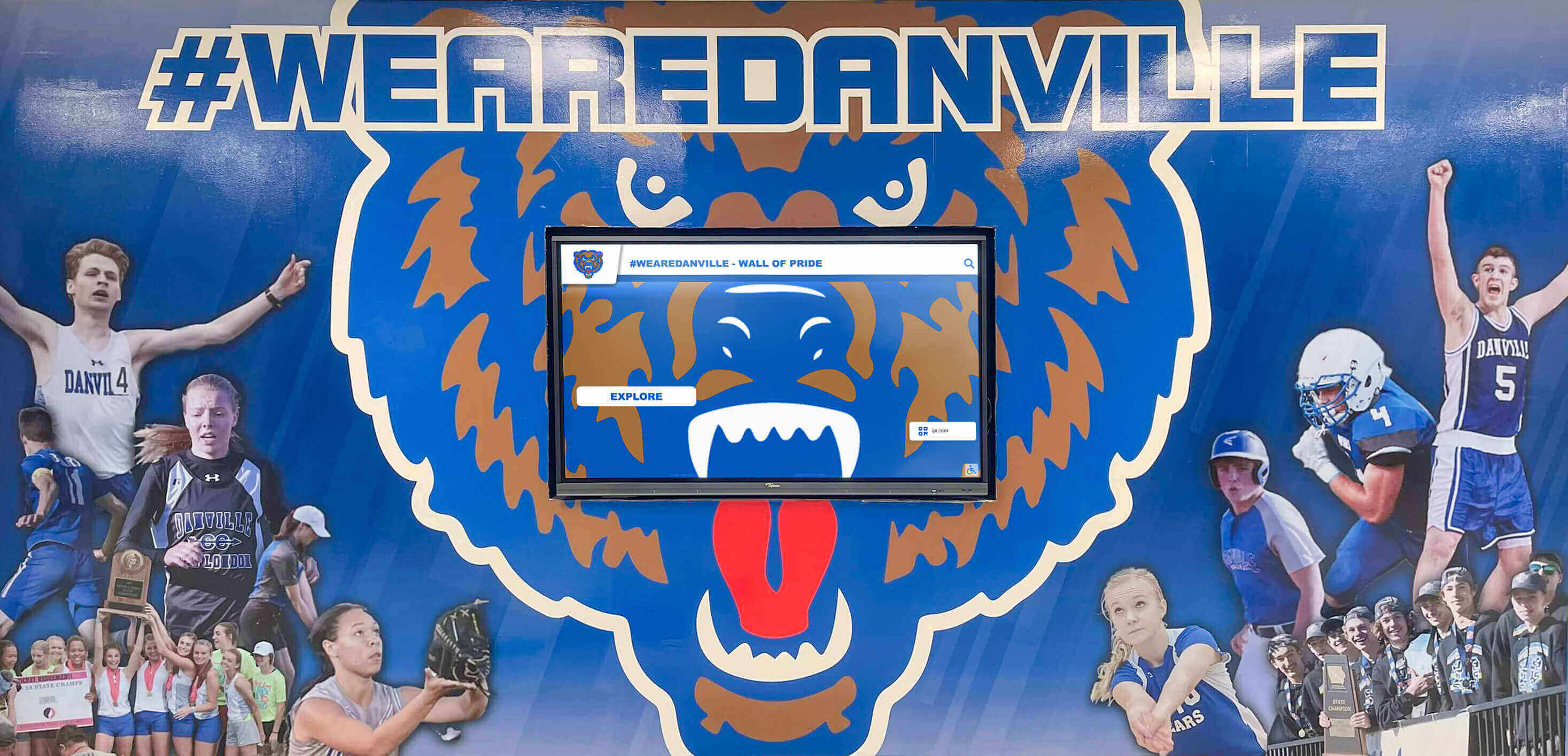
Analytics and Engagement Tracking
Modern digital systems provide valuable insights into how students interact with recognition:
Usage Metrics:
- Total daily interactions and unique visitors
- Average session duration (target: 3-7 minutes)
- Screens viewed per session
- Peak usage times and days
- Repeat visitor percentages
Content Performance:
- Most viewed athlete profiles and records
- Popular search terms revealing student interests
- Sport-specific engagement patterns
- Video completion rates
- Feature utilization data
Strategic Value:
- Demonstrate ROI through engagement data
- Identify underutilized content requiring enhancement
- Understand which sports generate most interest
- Optimize featured content based on viewing patterns
- Support decision-making about program investments
These analytics transform digital record boards from simple displays into strategic tools providing insights that inform athletic program decisions and justify continued investment in recognition.
Sports-Specific Record Board Applications
Different sports have unique recognition needs that digital record boards address effectively.
Track and Field Excellence
Track and field programs benefit enormously from digital organization:
Event-Specific Recognition:
- Separate displays for running, jumping, and throwing events
- Indoor and outdoor record distinctions
- Gender-specific and combined records
- Relay team recognition alongside individual achievements
- Historical progression showing record improvement over decades
- Multiple performance metrics (times, distances, heights)
Enhanced Context:
- Weather and track condition notations for context
- Competition level indicators (invitational, conference, state)
- Qualifying standard comparisons
- Athlete progression timelines showing improvement
- Coach commentary about achievements
- Video highlights of record-breaking performances
Swimming and Diving Programs
Aquatic programs have unique requirements digital boards address:
Pool-Specific Records:
- Adaptation to different pool lengths and configurations
- Short course and long course distinctions
- Event-specific records across all competitive categories
- Relay team achievements prominently featured
- Diving score records with detailed breakdowns
- Time standard displays for various competition levels
Comprehensive Coverage:
- Championship meet results and placements
- State and national qualifying times
- Team records alongside individual achievements
- Historical depth showing program growth
- Swimmer progression across multiple years
- Coach insights about training and development
For detailed guidance on swimming-specific record boards, schools should consult resources on swimming pool record displays that address aquatic program unique requirements.
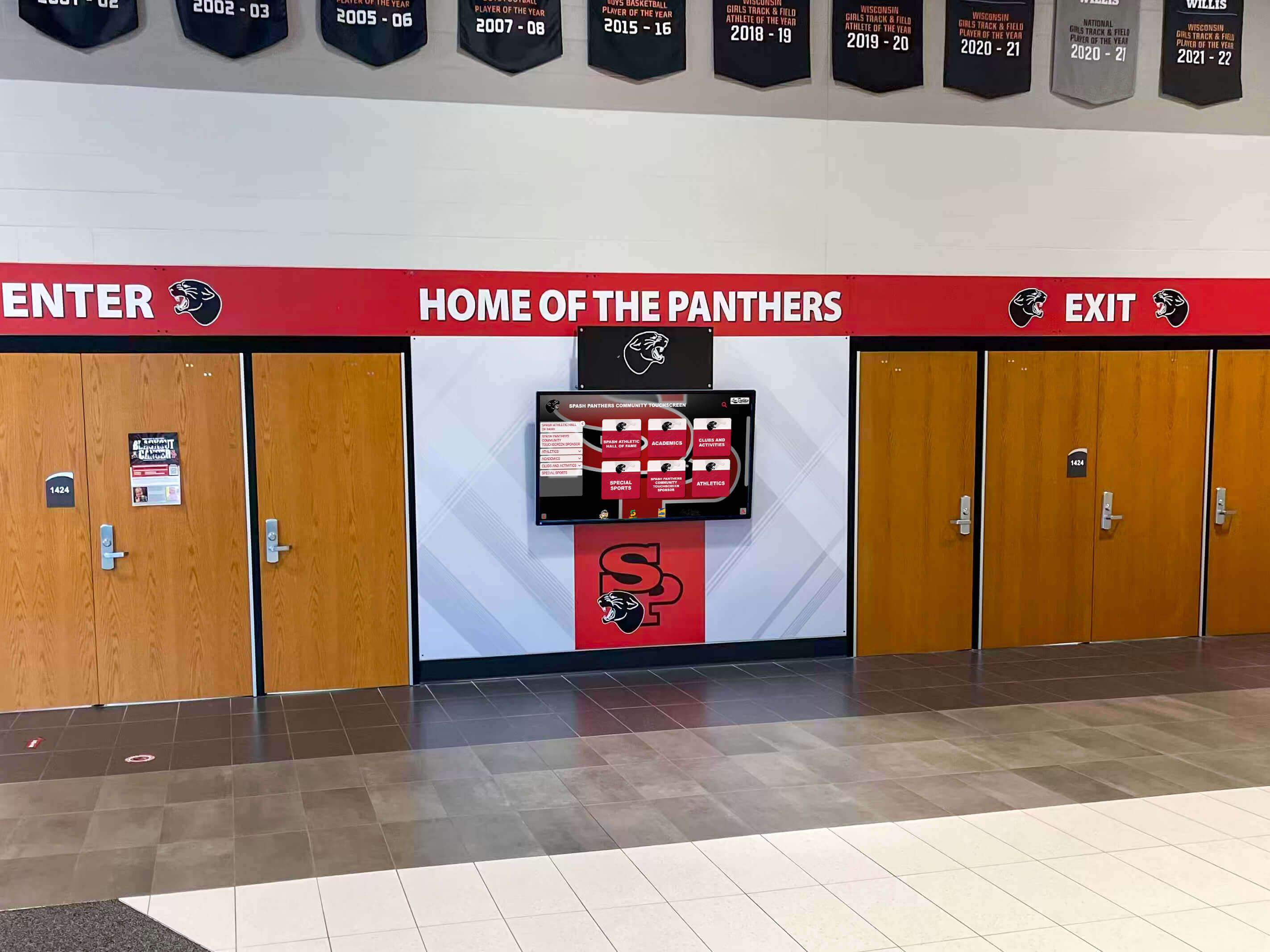
Multi-Sport Recognition Systems
Comprehensive athletic programs require integrated approaches:
Unified Display Strategy:
- All sports records accessible through single interface
- Seasonal rotation highlighting current sports automatically
- Cross-sport comparisons enabling interesting analysis
- Consistent recognition format across all programs
- Historical context showing total program development
- Search spanning all sports simultaneously
Flexible Organization:
- Browse by sport, season, year, or achievement type
- Featured content rotating based on active seasons
- Championship and playoff recognition across programs
- All-sport athlete recognition for multi-sport stars
- Coach profiles spanning multiple programs
- Comprehensive school athletic history preservation
Football, Basketball, and Major Sports
High-profile programs require depth and engagement:
Team Achievement Recognition:
- Season-by-season records and championships
- Game-by-game statistics and milestones
- Playoff and championship documentation
- Conference standings and awards
- Individual stat leaders by category
- Memorable game highlights and moments
Individual Excellence:
- Career statistical leaders (points, yards, wins)
- Single-game and single-season records
- All-conference and all-state selections
- College recruitment and commitment recognition
- Individual awards and honors
- Milestone achievements (1000 points, 100 wins)
Implementation Strategies for High Schools
Strategic planning ensures digital record board implementations deliver maximum value and sustained success.
Needs Assessment and Goal Setting
Begin with clear understanding of objectives:
Defining Recognition Goals:
- Which sports and achievement types require recognition?
- What historical depth should initial implementation include?
- Who are primary audiences (students, families, visitors, alumni)?
- What engagement outcomes define success?
- How will recognition integrate with broader school culture goals?
- What administrative efficiency improvements are priorities?
Current State Assessment:
- Inventory existing physical record boards and their condition
- Document which records are currently displayed
- Identify gaps in historical documentation
- Assess staff capacity for content development
- Evaluate technical infrastructure (internet, power, space)
- Review budget availability and funding sources
Thorough assessment prevents misalignment between expectations and implementation, ensuring the system meets actual needs rather than assumed requirements.
Location Selection and Placement Strategy
Display location fundamentally determines visibility and usage:
Optimal Location Characteristics:
- High-traffic areas where students naturally gather
- Sufficient space for comfortable viewing and interaction
- Adequate electrical power and internet connectivity
- Lighting conditions supporting screen visibility
- Protection from extreme temperatures and moisture
- Proximity to athletic facilities reinforcing context
Common High School Placements:
- Main gymnasium lobbies or entrances
- Athletic hallways connecting locker rooms and facilities
- School main entrance or commons areas
- Cafeteria spaces with extended dwell time
- Weight room or training facility areas
- Outdoor athletic complex entrances (with weather-rated systems)
Multiple displays in different locations maximize visibility across diverse student populations and visitor types, though most schools begin with a single prominent installation before expanding based on success and available budget.
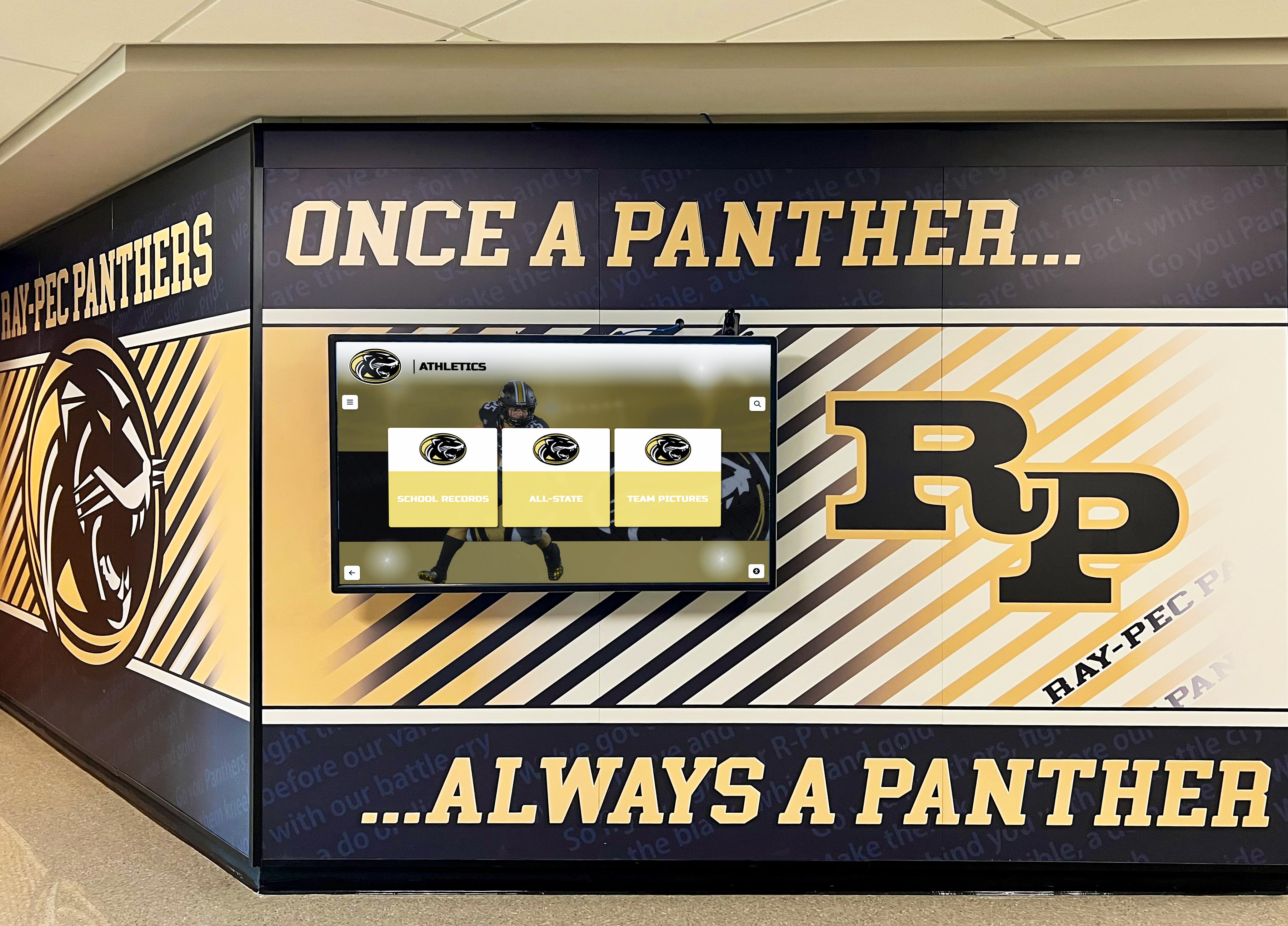
Screen Size and Hardware Selection
Matching display size to viewing distance ensures comfortable interaction:
Screen Size Guidelines:
43-55 Inch Displays:
- Intimate viewing spaces (8-12 feet)
- Smaller lobby areas or hallways
- Budget-conscious implementations
- Individual or small group interaction
- Starting point for pilot programs
55-75 Inch Displays:
- Standard lobby installations (10-15 feet)
- Most common implementation size
- Balance between visibility and cost
- Accommodates individual and group viewing
- Recommended for typical high school gymnasiums
75-98 Inch Displays:
- Large gathering spaces (15-25 feet)
- Prominent statement installations
- Event spaces with crowd viewing
- Maximum visibility and impact
- Premium installations for flagship programs
Hardware Quality Considerations:
- Commercial-grade displays rated for continuous operation
- Minimum 16-hour daily operation ratings
- Hardened glass surfaces resisting impacts
- 350-450 nits brightness for typical lighting conditions
- Minimum 3-year commercial warranties
- On-site service agreements for minimized downtime
Consumer displays designed for residential use typically fail within 18-24 months under school usage patterns. Commercial specifications deliver significantly lower total cost of ownership despite higher initial cost.
Content Development Planning
Launching with compelling content ensures strong first impressions:
Phased Content Strategy:
Phase 1 - Foundation Launch (Months 1-3):
- Current year records across all sports
- Recent 5-year record holders with basic information
- Essential athlete photos and graduation years
- Core statistics and achievement dates
- Basic team achievement recognition
- Simple interface navigation
Phase 2 - Enhancement (Months 4-6):
- Extended profiles with athlete narratives
- Coach testimonials and achievement context
- Photo galleries showing progression
- Recent video highlights
- Extended historical coverage (10 years)
- Related athlete connections
Phase 3 - Premium Depth (Months 7-12):
- Comprehensive historical archives
- Video interviews with athletes and coaches
- Documentary-style mini-profiles
- Alumni update features
- Historical photo collections
- Deep statistical analysis and trends
This phased approach enables timely launch with strong foundational content while creating a roadmap for continuous enrichment that maintains engagement over time.
Cost Considerations and Budgeting
Understanding investment requirements helps schools plan appropriately and secure necessary funding.
Initial Implementation Costs
Complete System Investment:
Comprehensive digital record board systems typically range from $10,000-$30,000 for initial implementation, including:
Hardware Components ($5,000-$15,000):
- Commercial-grade touchscreen display
- Industrial computing module
- Mounting hardware (wall-mount or freestanding kiosk)
- Cabling and power requirements
- Protective enclosures if needed
- Warranty and service agreements
Software Licensing ($2,000-$5,000 annually):
- Cloud-based content management platform
- Interactive touchscreen software
- Analytics and reporting capabilities
- Remote management tools
- Regular software updates and improvements
- Technical support access
Professional Services ($3,000-$10,000):
- Site assessment and planning consultation
- Professional installation and configuration
- Initial content development assistance
- Staff training on system operation
- Custom design and branding integration
- Project management and coordination
Investment varies based on display size, installation complexity, historical content depth, customization requirements, and vendor selection. Schools should request detailed proposals from multiple vendors to understand market pricing and value propositions.
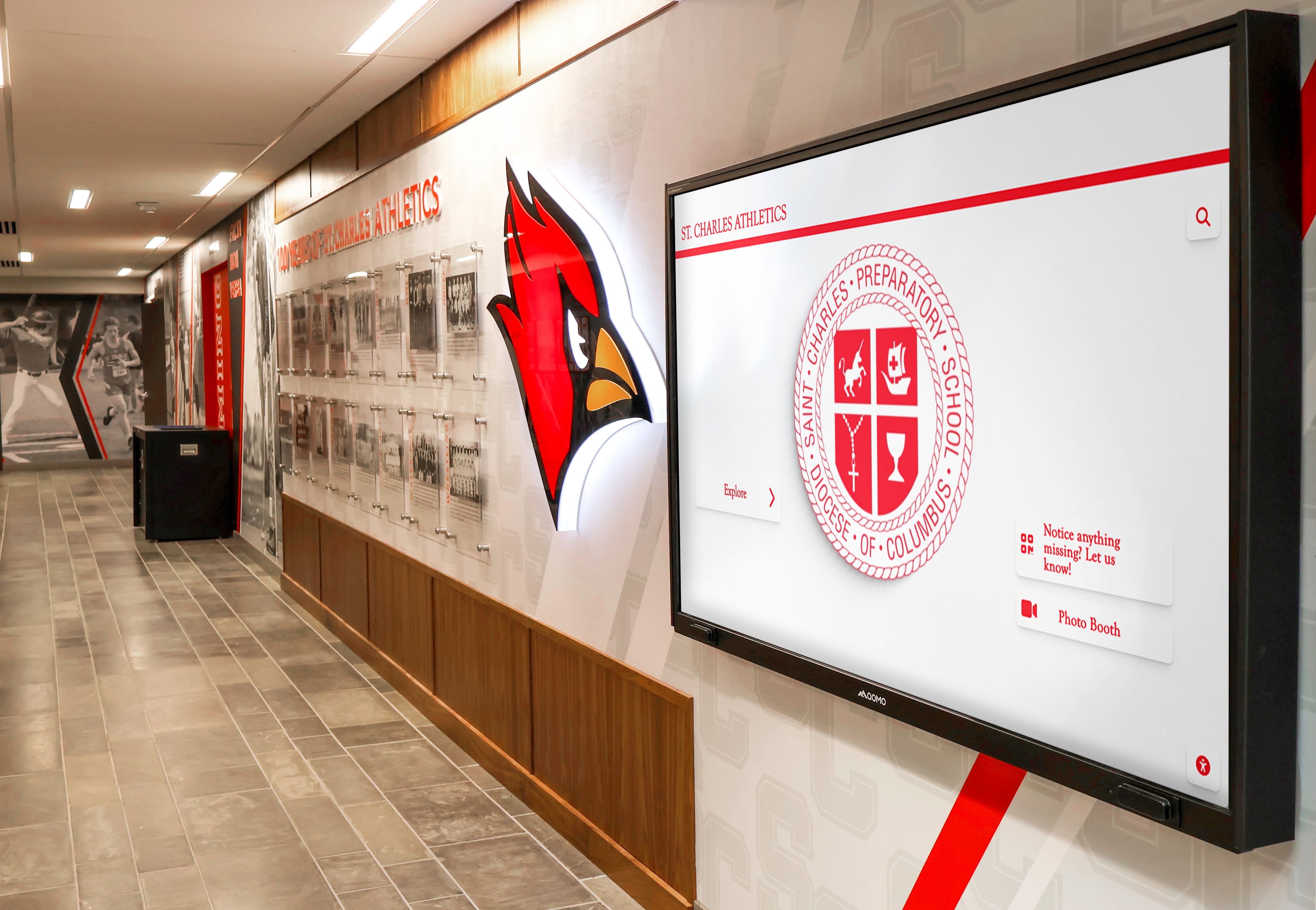
Ongoing Operational Costs
Annual Operating Budget:
After initial implementation, typical annual costs include:
Software and Licensing ($1,500-$3,000):
- Annual content management system licensing
- Software updates and new features
- Cloud hosting and data storage
- Analytics and reporting access
- Technical support
Content and Maintenance ($1,000-$3,000):
- Staff time for content updates (2-4 hours monthly)
- Photography for new inductees
- Video production if creating new content
- Periodic content audits and improvements
- Minor system maintenance and troubleshooting
Optional Enhancements:
- Professional content development services
- Hardware warranty extensions beyond standard coverage
- Additional displays expanding recognition reach
- Custom feature development
- Advanced analytics packages
Total annual operating costs typically range from $2,500-$6,000 depending on update frequency, content quality standards, and the level of professional support utilized versus in-house management.
Return on Investment Analysis
Digital record boards deliver value justifying investment:
Quantifiable Savings:
- Eliminated Material Costs: Traditional boards require $2,000-$5,000 annually for plaques, vinyl, mounting materials, and professional updates
- Reduced Labor: Digital updates taking 15-30 minutes replace physical updates requiring 2-4 hours plus travel and setup
- Space Efficiency: Single digital display consolidates recognition that would otherwise consume 100+ square feet of wall space
- Longevity: Commercial displays lasting 5-7+ years versus traditional materials requiring replacement every 3-5 years
Qualitative Value:
- Enhanced student engagement and motivation through interactive access
- Improved school pride and community connection
- Superior recruitment capabilities showcasing program excellence
- Preserved institutional history accessible to current and future generations
- Enhanced family engagement through compelling recognition
- Increased alumni connection and support
Most schools calculate break-even within 3-4 years based purely on material and labor savings, with ongoing value substantially exceeding traditional approaches through enhanced engagement and strategic benefits.
Funding Sources and Strategies
Schools successfully fund digital record boards through diverse sources:
Traditional Funding:
- Athletic department operating budgets
- Capital improvement funds
- Technology budget allocations
- Facilities maintenance and upgrade funding
Development and Fundraising:
- Booster club campaigns and special projects
- Alumni association funding or campaigns
- Corporate sponsorships from local businesses
- Memorial and honorific naming opportunities
- Crowdfunding campaigns engaging broader communities
- Grant applications from foundations supporting educational technology
Phased Implementation:
- Begin with single display in most prominent location
- Add additional locations as funding becomes available
- Start with essential features, add enhancements over time
- Demonstrate success to justify expanded investment
Many schools find that demonstrating success with initial implementation generates enthusiasm for expansion, with boosters and donors eager to support visible recognition celebrating their athletes and programs.
Benefits Beyond Athletic Recognition
Digital record boards provide value extending beyond simple record display.
Enhanced Student Motivation
Research in educational psychology demonstrates that visible peer achievement recognition increases student motivation:
Motivational Mechanisms:
- Social Proof: Seeing peers celebrated for specific achievements demonstrates that excellence is attainable rather than mysterious
- Clear Pathways: Detailed athlete profiles showing training, dedication, and progression provide concrete models students can emulate
- Aspirational Targets: Records displayed prominently create specific goals athletes can pursue
- Recognition Culture: Visible celebration of achievement communicates that excellence is valued and noticed
- Personal Connection: Interactive access enabling students to search for friends, siblings, or role models increases relevance and inspiration
Schools implementing comprehensive digital recognition consistently report that coaches reference the displays when motivating athletes, that students regularly explore records to understand program standards, and that visible recognition reinforces the culture of excellence programs work to build.
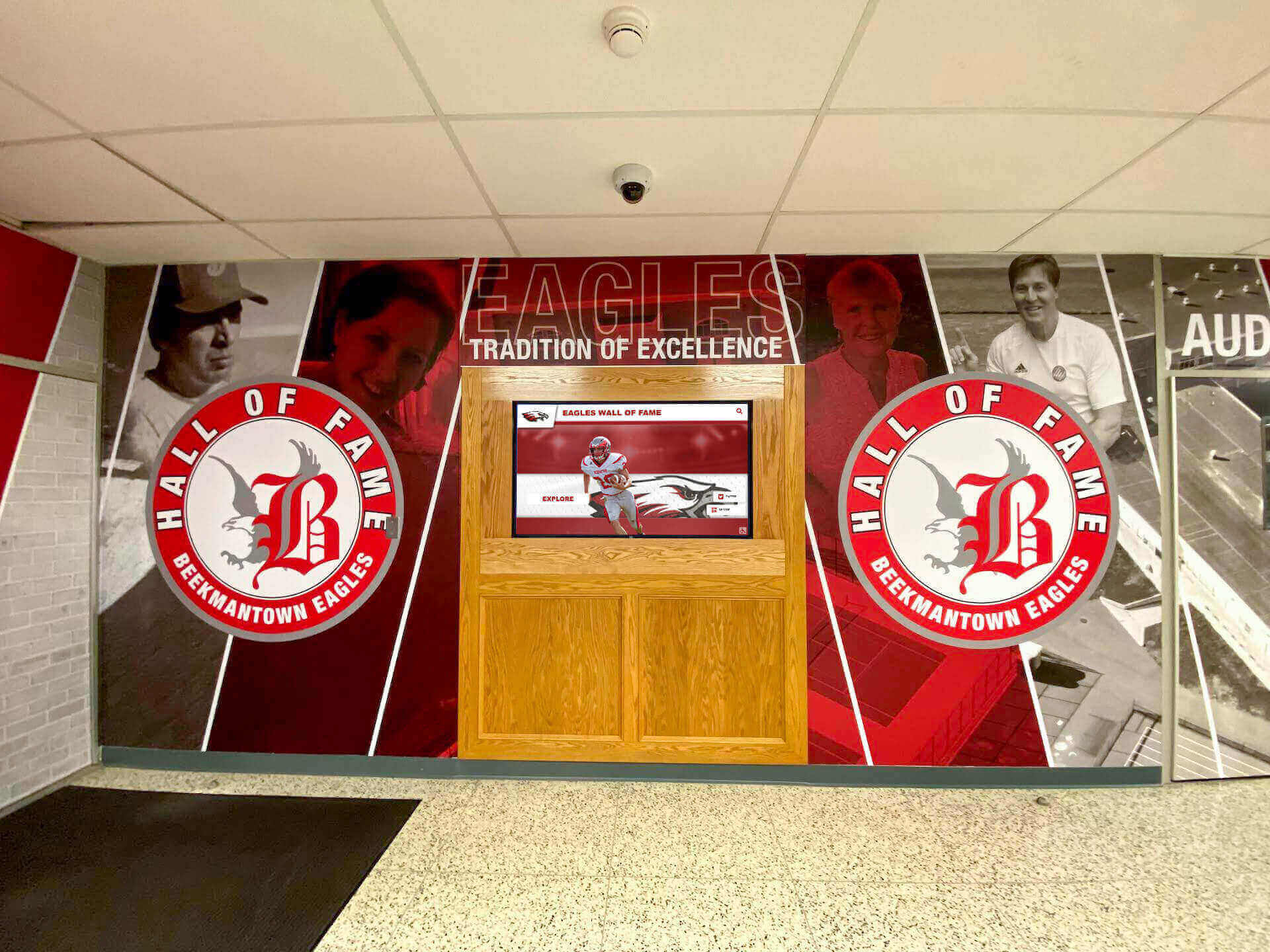
Strengthened School Pride and Community
Athletic recognition serves as focal point for school pride:
Community Impact:
- Shared Identity: Celebrated achievements become part of collective school identity that students, families, and alumni share
- Conversation Starters: Recognition displays create natural talking points during tours, events, and gatherings
- Historical Connection: Access to program history helps current students understand their place in longer traditions
- Family Engagement: Parents explore recognition enthusiastically, strengthening school-family relationships around celebration rather than only connecting during problem-focused conferences
- Alumni Connection: Recognition accessible online extends pride to graduates worldwide, supporting alumni relations and advancement efforts
High-profile recognition installations become signature features that families remember, share on social media, and associate with positive school experiences.
Improved Recruitment and Retention
Athletic recognition provides competitive advantages:
Recruitment Benefits:
- Prospective athletes visiting campus see evidence of program excellence
- Clear documentation of achievement standards helps athletes assess fit
- Families evaluate commitment to athlete recognition and program investment
- Modern recognition systems convey innovation and forward-thinking approach
- Comprehensive historical archives demonstrate sustained program quality
Retention Value:
- Current athletes feel valued when achievements receive prominent recognition
- Clear pathways to record-breaking motivate continued participation
- Team traditions and program culture become visible and tangible
- Recognition of all achievement levels (not just champions) demonstrates inclusive values
Athletic directors report that digital recognition systems become highlight features during recruitment tours, with prospective families frequently photographing displays and commenting positively about the investment in athlete celebration. Schools can explore additional approaches to building school pride through recognition that complement athletic achievement displays.
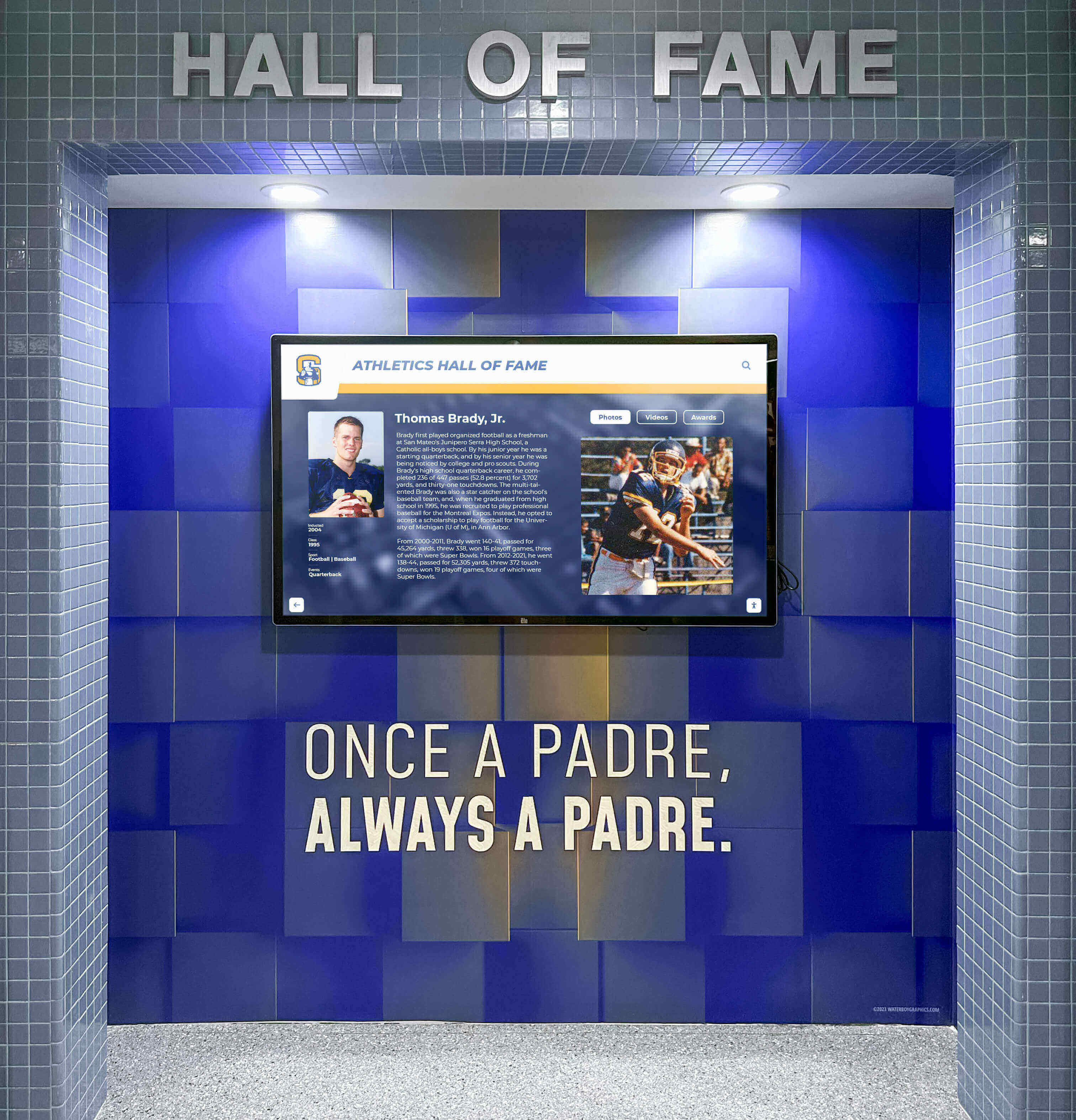
Preserved Institutional History
Digital systems excel at preserving athletic heritage:
Historical Value:
- Unlimited capacity enables comprehensive documentation of program history
- Digitization protects information from loss, damage, or degradation
- Search functionality makes historical information accessible rather than archived
- Regular engagement with historical content keeps traditions alive
- Connection between past and present athletes strengthens program culture
- Alumni can access their own records and achievements from anywhere
Many schools discover during implementation that significant historical achievements were never properly documented or have been lost over time. Digital systems provide motivation and framework for historical recovery projects that preserve institutional memory for current and future generations. Comprehensive approaches to honoring school history through digital recognition ensure that past achievements inspire continued excellence while strengthening community connections across generations.
Implementation Best Practices
Learning from successful implementations accelerates success and avoids common pitfalls.
Start with Compelling Content
Technology amplifies content quality—or exposes its absence:
Content-First Approach:
- Develop comprehensive content plans before finalizing technology purchase
- Gather athlete achievement information systematically
- Photograph subjects professionally or train student photographers
- Write compelling narratives rather than basic statistical lists
- Pilot content with focus groups (students, coaches, families) before launch
- Establish sustainable update workflows from day one
Schools that launch with thin content undermines entire investment. Students who explore a new digital display and find minimal information rarely return, while those discovering rich, engaging content become regular users and advocates who promote the system organically.
Design for Your Specific Program Culture
Generic implementations underperform compared to tailored approaches:
Customization Considerations:
- Reflect school branding (colors, logos, mascots, visual identity)
- Organize by sports prominent in your specific program
- Prioritize achievement types your community values most
- Use terminology and language matching your traditions
- Feature content appealing to your demographic makeup
- Integrate with existing recognition programs and ceremonies
One-size-fits-all templates feel impersonal and fail to resonate. Investment in customization that reflects unique program identity pays dividends through enhanced emotional connection and engagement. For comprehensive facility enhancement, schools might also explore basketball-specific record board solutions alongside multi-sport recognition systems.
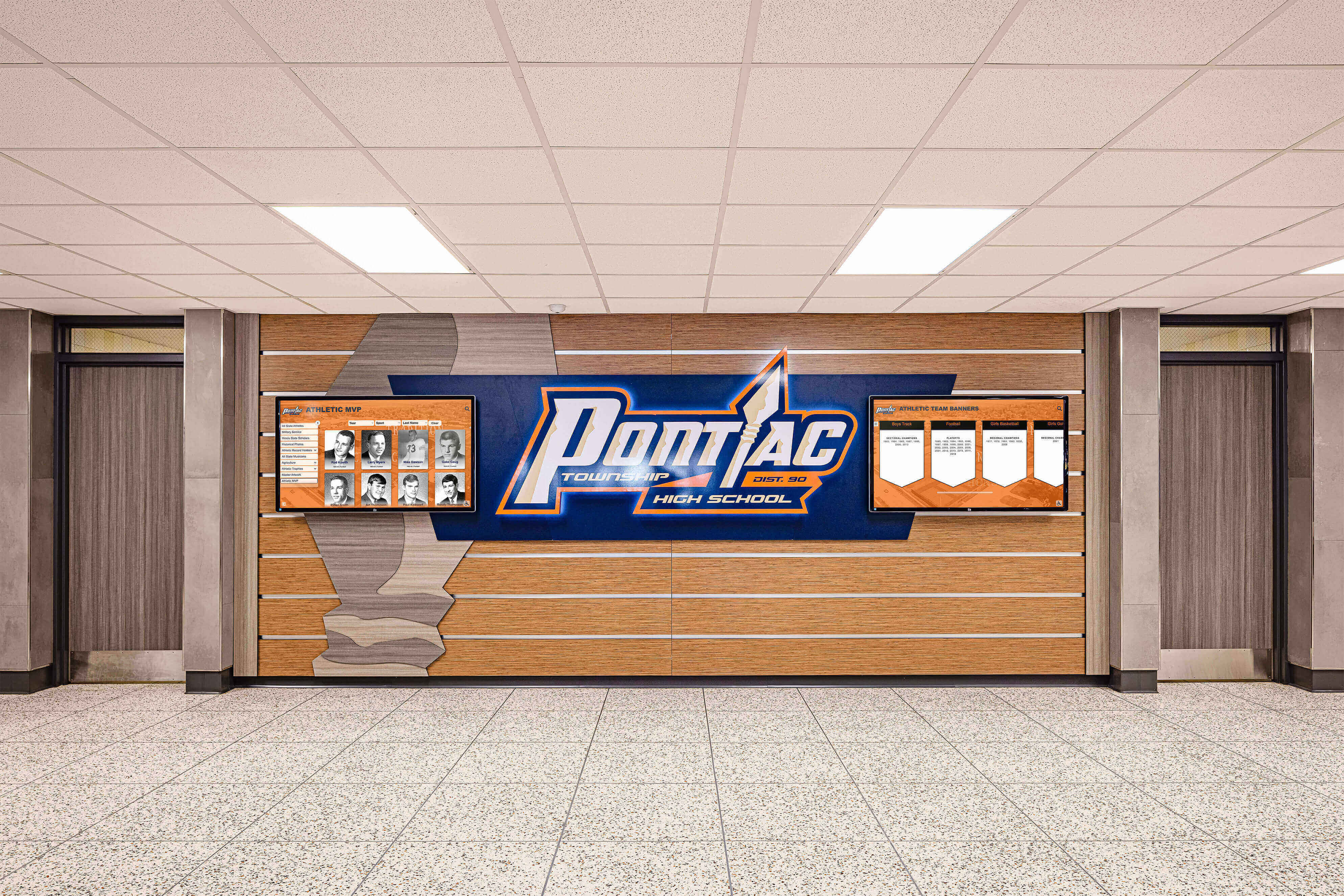
Promote Consistently and Creatively
Even excellent digital boards require ongoing promotion:
Launch Phase Promotion:
- School-wide announcement assemblies introducing the system
- Demonstrations during athletic banquets and recognition events
- Parent communication through newsletters and social media
- Local media coverage of the installation and first inductees
- Grand opening events with featured record holders
- Integration into athletic program marketing
Ongoing Promotion:
- Regular announcements highlighting newly added records
- Integration into campus tours for prospective families
- Seasonal content themes drawing attention to current sports
- Competitions encouraging exploration (scavenger hunts, trivia)
- Social media campaigns featuring profiles and achievements
- Event-driven features during homecoming, signing days, championships
Sustained promotion maintains awareness and prevents the display from fading into background infrastructure that students stop noticing.
Maintain Momentum Through Regular Updates
Static content causes engagement to decline rapidly:
Update Schedule:
- Weekly: Featured profile rotation, new achievement highlights
- Monthly: New record additions, seasonal sport emphasis
- Quarterly: Multimedia enhancement for existing profiles, thematic collections
- Seasonally: Sport-specific content tied to active seasons, end-of-season recognition
- Annually: Historical expansion projects, major content campaigns
Students who see identical featured content week after week stop checking for updates. Regular refresh communicates that recognition is current, ongoing, and comprehensive rather than historical and complete.
Common Challenges and Solutions
Understanding predictable obstacles helps schools navigate them effectively.
Challenge: Content Development Takes Longer Than Expected
Solution: Implement in phases starting with recent, well-documented achievements. Engage coaches directly to contribute information about their programs. Consider professional content development services for jumpstart. Treat content as ongoing program rather than one-time project.
Challenge: Technical Issues During Implementation
Solution: Work with experienced vendors offering comprehensive support. Build timeline buffers for problem resolution. Conduct thorough testing before public launch. Have backup plans for unveiling ceremonies. Document configurations for troubleshooting.
Challenge: Staff Concerns About Managing Technology
Solution: Choose platforms with genuinely intuitive interfaces requiring minimal training. Provide hands-on practice rather than lecture-based training. Create simple reference guides for common tasks. Establish internal support networks among tech-comfortable staff. Maintain vendor support relationships.
Challenge: Lower Than Hoped Initial Engagement
Solution: Verify display location provides high visibility and natural traffic. Promote extensively through multiple channels. Create programs specifically driving traffic (required assignments, scavenger hunts). Add compelling new content frequently. Gather feedback identifying improvement opportunities.
Challenge: Securing Ongoing Funding
Solution: Track and report engagement metrics demonstrating value. Connect recognition to measurable outcomes (motivation, pride, recruitment). Create naming opportunities for donors. Implement phased expansion tied to results. Secure annual operating budget allocation rather than one-time funding.
The Future of Digital Athletic Recognition
Digital record board technology continues evolving with emerging capabilities that will shape next-generation recognition.
Artificial Intelligence Integration
AI technologies enhance personalization and automation:
- Intelligent content recommendations based on user behavior patterns
- Automated profile generation from public data sources
- Natural language search and conversational interfaces
- Content gap identification suggesting needed additions
- Predictive analytics forecasting engagement trends
- Automated highlight video generation from game footage
Enhanced Mobile Integration
Deeper mobile connections amplify accessibility:
- Progressive web apps providing smartphone access to all content
- Mobile-first content creation tools for easy updates
- Push notifications about new records and achievements
- Augmented reality features overlaying information at physical locations
- Personal achievement portfolios for individual athletes
- Parent dashboards tracking athlete recognition history
Voice Interaction Capabilities
Emerging voice technology adds accessibility:
- Voice-activated search and navigation
- Audio descriptions for visual content
- Conversational interfaces enabling natural queries
- Hands-free operation supporting accessibility
- Multiple language support through voice
- Read-aloud capabilities for text content
Schools staying current with emerging trends maintain competitive advantages and maximize long-term value from their digital recognition investments.
Making the Decision: Is Digital Right for Your School?
Digital record boards deliver significant value, but represent meaningful investment requiring careful consideration.
When Digital Record Boards Make Sense
Digital solutions particularly benefit schools with:
Program Characteristics:
- Multiple sports requiring recognition across diverse achievement categories
- Limited wall space for traditional physical displays
- Aging physical boards requiring expensive replacement or renovation
- Significant historical records worth preserving and making accessible
- Desire to engage students through modern interactive technology
- Recognition spanning decades that’s difficult to maintain physically
Organizational Readiness:
- Staff capacity or willingness to manage digital content
- Budget availability for initial investment and ongoing operation
- Technical infrastructure (reliable internet, adequate power)
- Leadership support for modernization initiatives
- Culture valuing innovation and student engagement
Strategic Goals:
- Enhanced student motivation through visible achievement recognition
- Improved athletic recruitment through modern facility showcases
- Strengthened alumni engagement through accessible historical archives
- Increased school pride and community connection
- Administrative efficiency improvements reducing update labor
When Traditional Approaches May Suffice
Some schools may find traditional physical displays adequate if:
- Recognition needs are limited (single sport or few records)
- Updates occur infrequently (annually or less)
- Budget constraints make digital investment prohibitive
- Staff capacity for content management is very limited
- Technical infrastructure is inadequate
- School culture strongly prefers traditional approaches
However, even schools with limited immediate needs should consider that digital systems provide future flexibility as programs grow and evolve, whereas physical displays become increasingly difficult to expand once space is consumed.
Getting Started: Implementation Roadmap
Schools ready to implement digital record boards benefit from systematic approaches:
Phase 1 - Planning (Months 1-2):
- Form implementation team including diverse stakeholders
- Define recognition goals and success criteria
- Assess locations and technical requirements
- Develop preliminary budget and identify funding sources
- Create content inventory of existing achievements
- Research vendors and platform options
Phase 2 - Vendor Selection (Months 2-3):
- Request demonstrations and detailed proposals
- Evaluate platforms against defined requirements
- Check references from similar schools
- Review contract terms and ongoing commitments
- Select vendor and finalize specifications
- Establish project timeline and milestones
Phase 3 - Content Development (Months 3-5):
- Gather athlete achievement information systematically
- Photograph athletes and digitize existing materials
- Write compelling profiles and achievement narratives
- Create or collect video content
- Organize content using consistent structure
- Review and edit for quality and accuracy
Phase 4 - Installation and Testing (Month 5-6):
- Complete site preparation and infrastructure
- Install hardware and configure software
- Conduct comprehensive functionality testing
- Train staff on system operation
- Perform soft launch with pilot users
- Gather feedback and refine
Phase 5 - Launch and Ongoing Operations (Month 6+):
- Host grand opening event generating awareness
- Implement promotional campaigns driving usage
- Monitor analytics and gather feedback
- Continue systematic content expansion
- Establish regular update processes
- Plan future enhancements based on success
Conclusion: Celebrating Excellence with Modern Technology
Digital record boards transform how high schools recognize athletic achievement—moving from static displays students ignore to engaging experiences that inspire exploration, build pride, and motivate excellence. The technology addresses every limitation of traditional record boards while creating new possibilities for celebrating achievement with the depth, accessibility, and engagement that contemporary students expect and deserve.
Successful implementation requires more than purchasing equipment—it demands strategic planning, compelling content development, thoughtful design, sustained promotion, and ongoing commitment to maintaining relevance. Schools approaching digital record boards systematically, learning from successful implementations and avoiding common pitfalls, create recognition programs delivering value far exceeding investment through enhanced student motivation, stronger program culture, improved recruitment outcomes, and preserved institutional history.
The athletes competing for your school achieve remarkable things—breaking records, winning championships, demonstrating dedication and perseverance that deserve celebration. Digital record boards ensure these achievements receive recognition matching their significance, creating experiences that honor the past, celebrate the present, and inspire future excellence.
Ready to explore how digital record boards could transform your athletic recognition? Solutions like Rocket Alumni Solutions provide comprehensive platforms designed specifically for schools, combining intuitive content management, engaging user experiences, and dedicated support ensuring long-term success. Every record tells a story—digital boards help you tell those stories in ways that truly inspire.




































